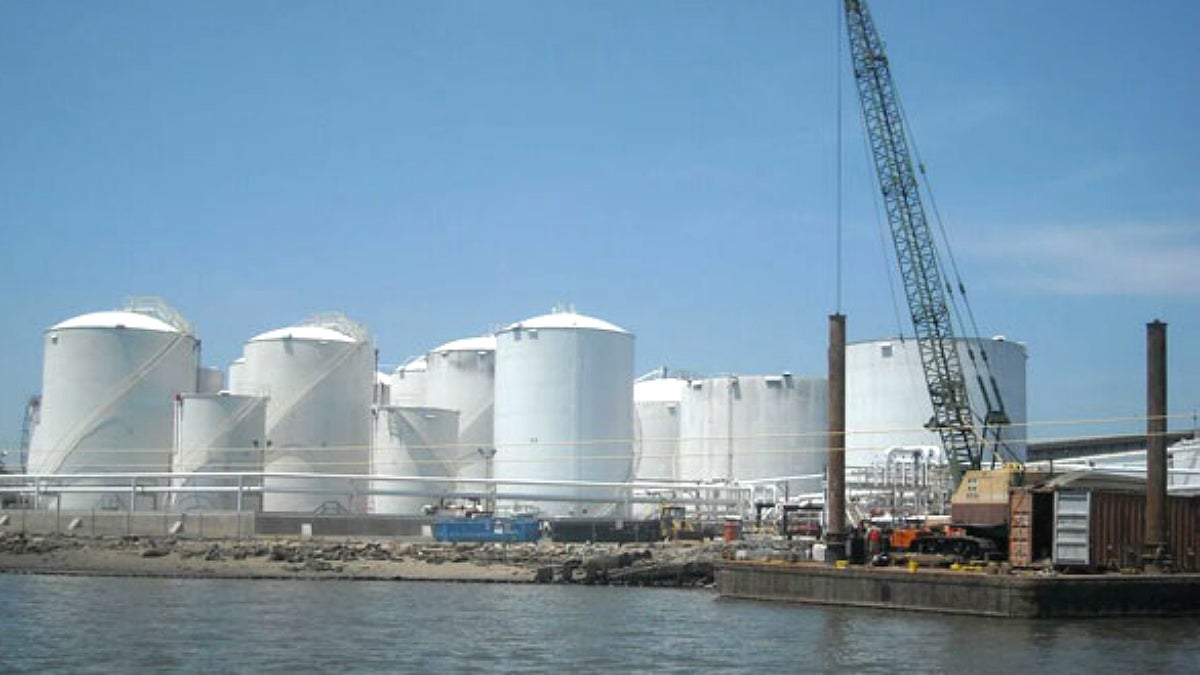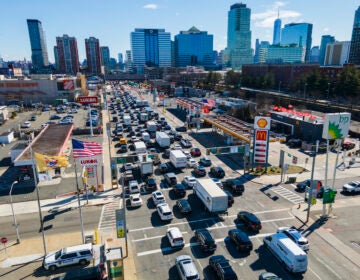New Jersey’s industrial coastline areas remain vulnerable to flooding

The Kinder Morgan biodiesel terminal in Carteret was one of several oil and gas facilities that flooded during Sandy.
 It was early on October 30, 2012, after the winds from Sandy had died down, when the call came in to the Coast Guard’s National Response Center hotline. Just before 5 a.m., a worker at the Motiva diesel terminal in Woodbridge said that flooding had caused an unknown quantity of fuel to leak into the Arthur Kill, between New Jersey and Staten Island.
It was early on October 30, 2012, after the winds from Sandy had died down, when the call came in to the Coast Guard’s National Response Center hotline. Just before 5 a.m., a worker at the Motiva diesel terminal in Woodbridge said that flooding had caused an unknown quantity of fuel to leak into the Arthur Kill, between New Jersey and Staten Island.
As day broke and employees were able to conduct a more thorough inspection, they realized that the storm had knocked over one of the storage tanks, sending hundreds of thousands of gallons of diesel into the river. Hundreds of workers were dispatched to the scene, and a massive cleanup and containment operation began, which would continue into the evening hours as a news helicopter hovered overhead.
The Coast Guard also received a call that morning from the Phillips 66 Bayway refinery in Linden, which reported a discharge of “slop oil” from the facility’s sewer system.
Then there were the calls from boaters and residents throughout the area who had seen rainbow sheens on the water, and someone reported a slick layer of oil covering tombstones and geese in a cemetery near the refinery.
In the three years since Sandy, the Christie administration — in partnership with the U.S. Army Corps of Engineers — has focused on rebuilding and fortifying beach towns along the Jersey Shore, as well as communities on the Raritan Bay.
But there’s another part of the waterfront that’s been largely forgotten. Unlike popular tourist destinations farther to the south with their beaches and boardwalks, the stretch of industrial coast in the northern part of the state is largely hidden from the average person, and it hasn’t received nearly as much attention in the Sandy recovery. Yet many of the facilities that operate there are essential to the region’s economy, and when they flood, they have the potential of affecting the health, safety, and livelihoods of thousands of people throughout the area.
Environmentalists and planning experts worry, however, that the state hasn’t been proactive enough with regulation and oversight to ensure that the sort of contamination that took place during Sandy won’t happen again.
As the head of New York/New Jersey Baykeeper, Debbie Mans is very familiar with this stretch of industrial coast. There aren’t any scenic roads or walkways along the waterfront here. In fact, the only way to get a good glimpse of it is to hop in a boat, so she points out landmarks along the shore while riding up the river.
“You move into the Arthur Kill, and all of a sudden you’re next to large tank farms, lots of pipelines, tankers, barges, and tugs, bringing in fuel and other products into the area,” she says, as we make our way under the Outerbridge Crossing. “And then you get up into the container terminals, the large port facilities.”
“As you get closer to the port [of Newark], you have a lot of industrial facilities, warehouse facilities. And these include chemical manufacturing. They produce fragrances and fat rendering for all your beauty products. And then we have one of largest wastewater treatment plants on the east coast right at the mouth of the Passaic River. This is how this area grew. The waterway was the primary mode of transportation for these facilities, and that’s where they are: right on the water’s edge. They’re all vulnerable to sea level rise and future storm events.”
“What happened here was that the storm surge came and funneled into these waters, and we saw significant damage all along this coast,” she continues.
“What we’re not seeing is a comprehensive look at how you make sure that these industries are making themselves flood proof, so that when a storm comes, the water doesn’t run into their facility and potentially run through into the communities like what happened during Hurricane Sandy,” she explains.
Ever since Sandy, officials like New Jersey Department of Environmental Protection Commissioner Bob Martin have promised to make the state less vulnerable.
“Wider beaches and protective dunes are part of our effort to protect the coastline from future storms,” he said in Asbury Park last May.
“I want to thank Governor Christie for his vision for a comprehensive coastal protection system. Again, his focus is to protect the coastline for homes, businesses, and infrastructure along the entire coast.”
But the state’s plan doesn’t cover the entire coast. Rob Freudenberg at the Regional Plan Association worries that no large-scale efforts have been make to protect the state’s industrial shoreline, due in part, he said, to the fact that it’s a difficult problem to solve.
“There’s no doubt that these are complicated sites,” he said. “They’re large, with large waterfront-facing areas. And there’s a significant amount of hazardous material on them, whether it’s their current processes or legacy toxins. This is not the kind of situation where a simple solution applies.”
Still, he said, whether it’s manmade sea walls or natural buffers like restored wetlands and underwater reefs to help absorb storm surges, the state needs to at least start having the conversation. Its approach so far, however, has largely been to leave the problem up to individual property owners.
“New Jersey’s Toxic Catastrophe Prevention Act (TCPA) rules were promulgated in 1988 and include a section (7:31-4.2) which requires facilities to perform a Process Hazard Analysis to identify all possible hazards which would include hurricanes, and take action to address the hazards to minimize the risk of accidental releases,” said Department of Environmental Protection spokesman Larry Hajna.
“In addition, the TCPA Rules require analysis of the likelihood of the hazards that impact beyond the facility property line; if the likelihood of a hazard occurring is greater than one in a million, further action is required to minimize the risk of accidental releases of hazardous chemicals,” he explained.
Beyond that, he pointed to the state’s “Discharges Of Petroleum and Other Hazardous Substances Rules,” which require property owners to prevent contamination from their sites from being carried off by or discharged into flood waters. NJ Spotlight reached out to Motiva and several other oil and gas facilities that flooded during Sandy, and they confirmed they’ve incorporated lessons learned and taken a variety of preventative measures, including stabilizing their tanks, raising electrical infrastructure, and installing stronger storm doors and waterproof walls.
But New Jersey hasn’t enacted any stricter regulations for such facilities since the storm, and Freudenberg says officials have yet to consider ways to address the problem as a whole.
“These industries are responsible for chemicals and toxins, oils, and raw sewage that could impact the entire region,” he said. “This is something that transcends any one, particular site. So I think this argues for a regional approach to ensure that the public health and the natural systems in our region are protected.”
What’s more, he warned that the problem could get even worse over time. With rising sea levels, about half of all power plants and sewage treatment plants in the region will be threatened by floodwaters by the middle of the century.
“I think we’ve made a lot of progress over the past decades in securing clean water,” he said. “Climate change and sea level-rise represents a major threat to undoing that work by flooding these sites with toxins on them.”
Building in resiliency takes time, he added, so we need to start planning now.
“We’re really in a race against the clock,” he said.
This story is part of Dirty Little Secrets, a series investigating New Jersey’s toxic legacy. Participating news partners include New Jersey Public Radio/WNYC, WHYY,NJTV, NJ Spotlight, Jersey Shore Hurricane News, WBGO, New Brunswick Today, and the Rutgers Department of Journalism and Media Studies. The collaboration is facilitated by The Center for Investigative Reporting, with help from the Center for Cooperative Media at Montclair State and support from the Geraldine R. Dodge Foundation to CIR.
___________________________________________________
NJ Spotlight, an independent online news service on issues critical to New Jersey, makes its in-depth reporting available to NewsWorks.
WHYY is your source for fact-based, in-depth journalism and information. As a nonprofit organization, we rely on financial support from readers like you. Please give today.




